
Beer is one of the oldest and most widely consumed alcoholic drinks in the world, and the third most popular drink overall after water and tea. It is produced by the brewing and fermentation of starches, mainly derived from cereal grains—most commonly from malted barley, though wheat, maize (corn), rice, and oats are also used. During the brewing process, fermentation of the starch sugars in the wort produces ethanol and carbonation in the resulting beer. Most modern beer is brewed with hops, which add bitterness and other flavours and act as a natural preservative and stabilizing agent. Other flavouring agents such as gruit, herbs, or fruits may be included or used instead of hops. In commercial brewing, the natural carbonation effect is often removed during processing and replaced with forced carbonation.

Brewing is the production of beer by steeping a starch source in water and fermenting the resulting sweet liquid with yeast. It may be done in a brewery by a commercial brewer, at home by a homebrewer, or communally. Brewing has taken place since around the 6th millennium BC, and archaeological evidence suggests that emerging civilizations, including ancient Egypt and Mesopotamia, brewed beer. Since the nineteenth century the brewing industry has been part of most western economies.

Kvass is a fermented cereal-based non-alcoholic or low alcoholic beverage with a slightly cloudy appearance, light-dark brown colour and sweet-sour taste. It may be flavoured with berries, fruits, herbs and honey.

Bread is a staple food prepared from a dough of flour and water, usually by baking. Throughout recorded history and around the world, it has been an important part of many cultures' diet. It is one of the oldest human-made foods, having been of significance since the dawn of agriculture, and plays an essential role in both religious rituals and secular culture.

Ethanol fermentation, also called alcoholic fermentation, is a biological process which converts sugars such as glucose, fructose, and sucrose into cellular energy, producing ethanol and carbon dioxide as by-products. Because yeasts perform this conversion in the absence of oxygen, alcoholic fermentation is considered an anaerobic process. It also takes place in some species of fish where it provides energy when oxygen is scarce.
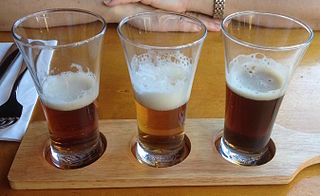
Beer styles differentiate and categorise beers by colour, flavour, strength, ingredients, production method, recipe, history, or origin.
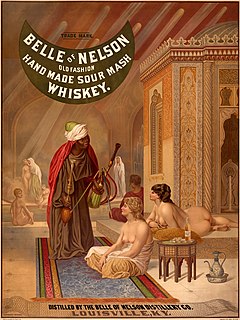
Sour mash is a process used in the distilling industry that uses material from an older batch of mash to start the fermentation of a new batch, analogous to the making of sourdough bread with a starter. The term can also be used as the name of the type of mash used in such a process, and a bourbon made using this process can be referred to as a sour mash bourbon.

Beer is one of the oldest drinks humans have produced. The first chemically confirmed barley beer dates back to the 5th millennium BC in modern-day Iran, and was recorded in the written history of ancient Egypt and Mesopotamia and spread throughout the world.
Ogi is a fermented cereal pudding from Nigeria, typically made from maize, sorghum, or millet. Traditionally, the grains are soaked in water for up to three days, before wet-milling and sieving to remove husks. The filtered cereal is then allowed to ferment for up to three days until sour. It is then boiled into a pap, or cooked to make a creamy pudding. It may be eaten with moin moin, akara or Bread depending on individual choice.
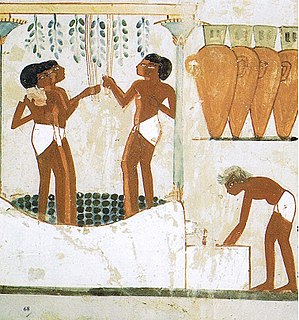
In food processing, fermentation is the conversion of carbohydrates to alcohol or organic acids using microorganisms—yeasts or bacteria—under anaerobic (oxygen-free) conditions. Fermentation usually implies that the action of microorganisms is desired. The science of fermentation is known as zymology or zymurgy.

Korn, also known as Kornbrand or Kornbranntwein, is a German colorless distilled beverage produced from fermented cereal grain seed. In the production of Korn only the cereal grain types rye, wheat, barley, oats and buckwheat are permissible. Most of the production is based on rye or wheat; barley is mainly used to obtain the required malt for the brewing process, while oats and buckwheat are rarely used. The addition of food colorings, flavorings, or sweeteners is not permitted. Korn differs from vodka in that it is distilled to lower alcoholic proofs and less rigorously filtered, which leaves more of the cereal grain flavor in the finished spirit.

A fermentation starter is a preparation to assist the beginning of the fermentation process in preparation of various foods and alcoholic drinks. Food groups where they are used include breads, especially sourdough bread, and cheese. A starter culture is a microbiological culture which actually performs fermentation. These starters usually consist of a cultivation medium, such as grains, seeds, or nutrient liquids that have been well colonized by the microorganisms used for the fermentation.
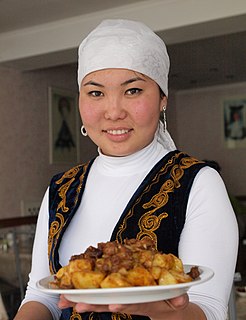
Kyrgyz cuisine is the cuisine of the Kyrgyz, who comprise a majority of the population of Kyrgyzstan. The cuisine is similar in many aspects to that of their neighbors.
The sponge and dough method is a two-step bread making process: in the first step a sponge is made and allowed to ferment for a period of time, and in the second step the sponge is added to the final dough's ingredients, creating the total formula. In this usage, synonyms for sponge are yeast starter or yeast pre-ferment. In French baking the sponge and dough method is known as levain-levure. The method is reminiscent of the sourdough or levain methods; however, the sponge is made from all fresh ingredients prior to being used in the final dough.

An alcoholic drink is a drink that contains ethanol, a type of alcohol produced by fermentation of grains, fruits, or other sources of sugar that acts as a drug. The consumption of alcoholic drinks, often referred to as "drinking", plays an important social role in many cultures. Most countries have laws regulating the production, sale, and consumption of alcoholic beverages. Regulations may require the labeling of the percentage alcohol content and the use of a warning label. Some countries ban such activities entirely, but alcoholic drinks are legal in most parts of the world. The global alcoholic drink industry exceeded $1 trillion in 2018.
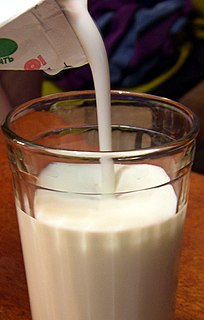
Kefir, is a fermented milk drink similar to a thin yogurt or ayran that is made from kefir grains, a specific type of mesophilic symbiotic culture. The drink originated in the North Caucasus, in particular the Elbrus environs along the upper mountainous regions of Circassia, Karachay and Balkaria from where it came to Russia, and from there it spread to Europe and the United States, where it is prepared by inoculating the milk of cows, goats, or sheep with kefir grains.
Parakari is a fermented alcoholic beverage made by Amerindians of Guyana. Like other cassava alcoholic beverages, parakari is made by dual fermenting cassava, which involves the use of an amylolytic mold by chewing it.
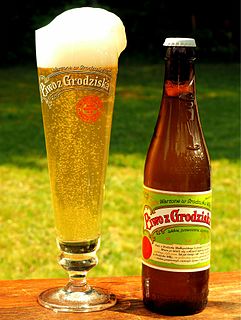
Grodziskie is a historical style of beer from Poland that is typically made from oak-smoked wheat malt. The beer can be described as having a clear, light golden color, high carbonation, low alcohol content, low to moderate levels of hop bitterness, and a strong smoke flavor and aroma. The taste is light and crisp, with primary flavors coming from the smoked malt, the high mineral content of the water, and the strain of yeast used to ferment the beverage. The beer was nicknamed "Polish Champagne" because of its high carbonation levels, and because it was valued as a high-quality beverage to be used for special occasions.

A malt drink is a fermented drink in which the primary ingredient is the grain, or seed, of the barley plant, which has been allowed to sprout slightly in a traditional way called "malting" before it is processed.














